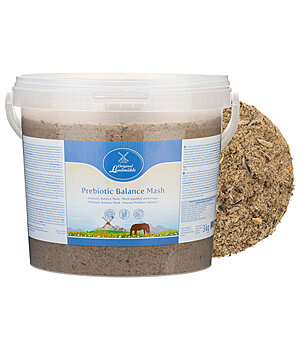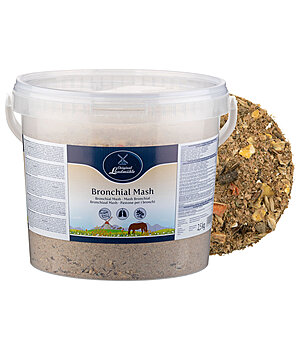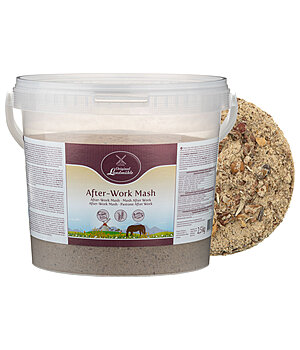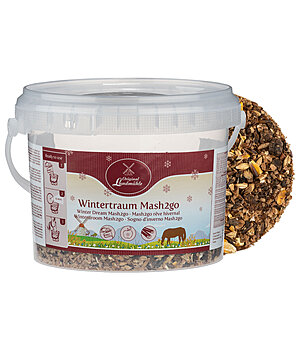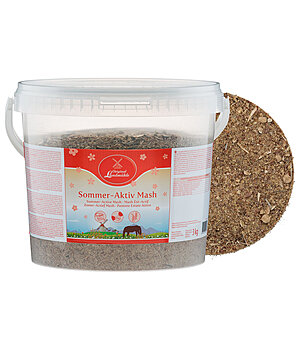What kind of hard feed and roughage does my horse need?
The horse is a continuous grazer, which in nature would graze for at least 16 hours a day and constantly eat small amounts of feed. Our domesticated horses also have this need, as the feeling of satiety only sets in after a certain number of chews. Due to its coarseness and composition, roughage forms the basis in horse feeding. Hard feed can be fed as a supplement, depending on the intensity of work.

What is roughage and why is hay so important for horses?
The term roughage includes dry roughage (hay, straw) and moist roughage (haylage). In general, roughage includes all types of feed that have a high proportion of dry matter. Dried grass in the form of hay may have a maximum residual moisture of 15% in order not to cause faulty fermentation in the horse’s digestive tract. In the case of moist roughage such as haylage, the residual moisture is approx. 30% higher than in the case of hay.
Roughage is important for the horse because it provides the horse with many hard-to-digest, plant-based structural elements. The horse can only digest cellulose, hemicellulose and pectin thanks to the 20 kilograms of bacteria in the large intestine. These release essential vitamins, trace elements and minerals for the horse, which it can then absorb through the intestinal wall.

In addition to the sensitive digestive system, chewing plays an important role for the horse as a continuous grazer. The horse’s stomach does not have stretch receptors like a dog’s stomach, for example, which gives the animal a feeling of satiety when it is filled to a certain level. For the horse, the number of chewing strokes per minute plays an important role. A hay-eating horse makes about 3,500 chewing movements in one hour, but is only full after about 35,000 chewing movements. So that the horse does not gorge, but chews its hay comfortably and salivates properly, so-called slow feeders, such as hay nets, are recommended.
Roughage is also important for dental health. Horse teeth regrow 2-3 millimetres a year and wear down by chewing coarse feed. If the feed is too fine, the teeth are not rubbed down hard enough resulting in irregularities and sharp edges in the dentition which have to be corrected by a horse dentist at an early stage.
Which roughage is best for horses?

Apart from excellent cleanliness and quality, it also depends on the ingredients, nutrients and structure of the feed. In principle, coarse, stalky feed is better for the horse’s dental health. However, there are also hard stalks that contain too much lignin. Lignin, for example, is present in straw with a content of 18% and is difficult to digest even for the horse’s intestinal bacteria. Therefore, feeds with a high lignin content must only be fed as a supplement and not as the main feed, as otherwise constipation colic may occur. Alfalfa can also often be too coarse and is therefore reluctantly eaten by horses.
Optimal for horses is hay after the first cut, which was mown in the midst of the grass flowering. Then the grass has a good structure that is not too hard, but also not too soft. The energy content and the proportion of crude protein are beneficial for the horse.
Hay cut before flowering or after the second cut is usually very fine and does not satisfy the horse’s need to chew. In addition, the horse is encouraged to gorge, which can lead to colic and pharyngeal blockages. Likewise, the proportion of proteins is higher in the cut before flowering, which can have negative effects on horses prone to metabolism.
Can hay be substituted?
Basically, an alternative for hay should only be sought if the horse is prohibited or unable to eat hay for valid reasons. Roughage in the form of hay is the basic feed that should make up the largest part of the horse’s diet. Valid reasons to source a hay substitute are:
- Hay and dust allergies
- Metabolic diseases (EMS, insulin resistance, laminitis)
- Bad teeth, for example in old horses
- Hay shortages
- Poor storage capacity of hay
- Mouldy hay
Some good and horse-friendly alternatives for hay are:
- Green meal cubes (young, soft grass dried and pressed).
- Grass cobs (older grass dried and pressed)
- Hay cobs (compressed hay)
- Alfalfa cobs
- Loose alfalfa fibre
- Meadow hay dried using a drying process
- Haylage / Silage (due to the lactic acid fermentation during ensiling, the feed is very acidic and also contains a lot of protein. The horse’s organism can become over-acidic by using up the body’s own sodium carbonate reserves. If you cannot refrain from feeding silage, a high-quality vits and mins supplement is essential.)

Please note that these alternatives cannot or should not completely replace the supply of high-quality hay, but rather are viewed as a supplement or enhancement. Hay can only be completely replaced in an extreme emergency.
What kind of hard feed does my horse need?

Hard feed serves solely as a supplement to the horse’s basic diet, which consists of high-quality roughage. Many horse owners mistakenly regard hard feed as the horse’s main source of energy if the horse is too thin or lacks energy. It may well be that the horse is a poor doer and therefore needs to be fed more oats, mixes, etc. Or the horse is in hard work for which the energy supply from the roughage is no longer sufficient – in this case it makes sense to give the horse hard feed. In general, roughage should be the horse’s main source of energy.
When choosing the right hard feed, starch digestibility plays an important role in addition to energy content. But other ingredients such as apple pomace, molasses and flavourings must also be taken into account when choosing.
Hard feeds, also called concentrates, are roughly divided into straights (oats, barley, maize) and compound feeds (mixes, cubes) and dietary feed (mash).
If you want to supply your horse with energy without any additives, it is best to use straights. In horse feeding, oats have proven to be the best and are also eagerly eaten by horses. A wider range of ingredients can be found in compound feeds. Mixes and cubes are available in a wide variety of compositions and can therefore be fed for different needs of the horse.
Which straights are available?
Oats are the most suitable feed for horses. Oats have many unsaturated fatty acids, only 11 MJ digestible energy, but a high starch digestibility of 80%. The energy supply is optimal for the horse. The phenomenon that oats are said to make horses hot is not due to their ingredients, but to their good digestibility. Horses that are fed quantities of oats that exceed their needs quickly become „fizzy“. A diet adapted to the workload prevents this phenomenon.
Oats contain a lot of lysine, an important amino acid that provides building blocks for cell and muscle development. The mucilage contained in oats has a positive effect on digestion, as the feed pulp is salivated and thus made easier for the digestive juices to penetrate.
A barley grain has more starch than an oat grain, but with 22% it has a much lower starch digestibility. Barley is therefore difficult for the horse to digest and can cause laminitis.

Maize is also difficult for the horse to digest. Maize contains the most starch of all manger feeds for horses, but has an equally low starch digestibility. However, maize is particularly suitable for extremely thin horses that need to be fattened up. The grain contains a lot of fat, but is also low in protein and crude fibre. In order to make the starch more easily usable for the horse, the maize grain is thermally broken down. Pure rolling or crushing is not sufficient. Treated with heat, the horse’s intestine can better utilise the maize flakes.
But be careful!
Rolled, ground or thermally broken down feed cannot be stored as long as untreated ones. The surface of the grains is destroyed and thus offers mould spores, bacteria and fungi a larger surface area to develop. You can find out more about storing feed here.
Compound feeds – Are mixes better for my horse than cubes?
Many horse owners perceive mixes as more natural and healthier than cubes. Yet both types of compound feed hardly differ in their components. The difference lies in their production: cubes are pressed together under heat, so the individual ingredients are no longer visible from the outside, whereas with mixes you can see the individual ingredients exactly. Both types of compound feed have their advantages and disadvantages.
The wide variety of mixes for horses

Mixes are a complete compound feed that is often fully vitaminised and mineralised. Therefore, a vits and mins supplement is only necessary if less mix than recommended by the manufacturer is fed and therefore a comprehensive supply of minerals and vitamins is not guaranteed.
Mixes often consist of different types of grain, dried vegetables and alfalfa. The ingredients are chopped and mixed well. Apple pomace and molasses are added for better cohesion, shelf life and taste. Structure-rich mixes support the chewing activity and saliva formation due to the high crude fibre content, which are beneficial for digestion.
Depending on the needs and requirements, mixes are available in different flavours, structures and compositions. For horses with laminitis, EMS or good doers, grain-free, starch and sugar-reduced mixes with a high crude fibre content are ideal. Senior horses get more energy from mixes that are easy to digest and chew. Sport horses, which need essential amino acids for muscle development, are supported by a sport mix that provides easily available energy with vegetable oils and broken down starch.
The disadvantage of mixes can be seen as the treated (rolled, popped, hydrothermally digested) grains. They make the feed more susceptible to fungal and mould spores. This reduces the shelf life, especially if the mixes are not stored in a dry place and protected from light. Similarly, if stored poorly, the high moisture content in the mixes can make the compound feed a magnet for mites, fungi and bacteria. However, the added molasses makes mixes last as long as cubes. The sugar, however, can have an unfavourable effect on the health of horses sensitive to metabolism. These processes are more extensive in the mix production than in cube production, which is why mixes often turns out to be more expensive than cubes.

What are cubes for horses?

Cubes for horses are compound feed ingredients that are heated, compacted and kneaded under high pressure. The mass is finally pressed into cube form and broken. Although the ingredients are no longer visible from the outside, they are still rich in vitamins, minerals, dried vegetables, repellents, oil and molasses for shelf life. Cubed feed can appear as a complete hard feed as well as a complementary feed and a vits and mins supplement. Cubes are usually cheaper than mixes, but their storage is less problematic, as they do not form a surface for dust and mites to attack and spoilage is therefore low. In addition, a lot of feed is strongly compressed, so it is more space-saving.
Nevertheless, nutrients, vitamins and minerals can be lost due to the high heat in the production process. The manufacturing process limits the variety of cubes, as not all raw materials are suitable for cubing. In addition, the surface of the cubes are very smooth and horses tend to swallow them unchewed. In order to prevent bolting, the preceding feeding of hay is particularly important.
Mash for horses – the puree only for sick horses?
Mash is the diverse treat for horses that has a dietary effect and positive effects on digestion. Traditionally, mash consists of bran and linseed in combination with other ingredients, which are infused with hot water. In the warmth, the swellable ingredients develop their slimy substances. The mash is then given to the horse lukewarm.
Mash is rich in vitamins, minerals and trace elements. Due to the high proportion of mucilage present in the bran, mash is ideal for horses with intestinal disorders, colic, free faecal water syndrome or diarrhoea. The mucilage forms a protective film around the intestinal wall and protects it from irritation.

The linseed contained in the feed promotes a shiny coat and provides energy during the coat change and in winter. But also old horses and horses with dental problems benefit from the mushy feed, which is easy to eat. Mash feeding also increases fluid intake, as the feed is mixed with water. Accordingly, sport horses also benefit from the warm treat after hard work with a lot of fluid loss.
How often should mash be fed?
Ideally, you feed the mash in addition to or instead of the usual hard feed 2 to 3 times a week. This is how often you can safely feed it to your horse. Daily feeding should be discussed with a veterinarian and should only be done in certain cases, such as the care of senior horses. This is because the wheat bran contained in mash is very high in phosphorus and can therefore inhibit calcium absorption. This promotes the demineralisation of the bones. Therefore, always pay attention to a balanced calcium-phosphorus ratio of 2:1. If the manufacturer states that the mash may be fed daily, a balanced ratio of the two quantity elements is guaranteed.



